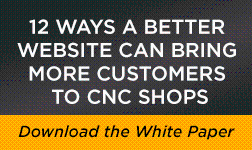A CNC shop owner recently lamented that the machining business is a perfect example of “feast or famine.” It’s true that shop owners have a tendency to actively look for new jobs only when the pipeline is emptying. Otherwise they’re focused on getting work out the door as efficiently and cost-effectively as possible.
As discussed in this space before, there are a number of marketing tools you can use to promote your business, including your Web site, emails, PR, and more. One that is a powerful yet inexpensive tool is a Web Log, commonly called a “blog.” Your blog can help create awareness, establish credibility, attract new customers and strengthen existing relationships. But how does this blogging stuff work? While there are no set rules, here are five factors that successful blogs have in common:
- Know the audience and provide value. A business blog is not about you, but rather about providing value to the reader. Therefore, as in any other marketing exercise, you need to know the issues your customers are concerned about and then provide helpful information. For example, if you have recently saved a customer money because you have a unique capability, tell the story focusing on the result first: “How We Saved An Automaker X%” and then explain how you did it. No need to give away any trade secrets, but make it clear that you refined a process or used advanced technology, etc.
- Establish objectives. The only way you’ll know for certain that your blog is working is to set measureable objectives. So what do you want your blog to do? Generate more traffic to your Web site? Get people to sign up for newsletters? Request a quote? These are all actions you can track and analyze, and may generate opportunities for further interaction. Other objectives, like building relationships, are more difficult to assess but prove valuable over time.
- Be well planned.
- Who will write the blogs? Do they communicate well: Can they write clearly, and concisely? Do they truly understand the customer’s needs? Do they understand the objectives? Do they have the time to blog consistently?
- How often should you blog? You want to blog with enough frequency to build readership, but not exhaust your writer or your readers. It helps to set up a monthly or even quarterly schedule of blogging topics and posting dates to help you stay on track. Whatever frequency you establish, be consistent.
- What will you blog about? Develop a list of blog subjects that cover many aspects of what your customer is looking for. You can also ask a few trusted customers what they’d like to read about.
- Link to additional blogs. If you touch on related subjects in a posting, link to previous blogs that discuss it in more depth. Plus, if I visit your blog and like what I read, I may want to see if you’ve blogged about unrelated topics that interest me. If possible provide a search function that lets readers easily find your blogs on these other topics.
- Have a call for action. OK, someone has been reading your blog and they’re considering doing business with you. What would you like them to do next? Call you? Email? Text? Visit your Web site? Subscribe to your e-newsletter? Come by and meet your people? I don’t know. And neither will your blog reader unless you tell them how to get hold of you.
If this seems overwhelming you may want to consider hiring a professional blogger (yes, they do exist) to provide your content. Just remember: Anything you post should be authentic and customer-focused, as readers are quickly turned off by self-serving drivel.
 |